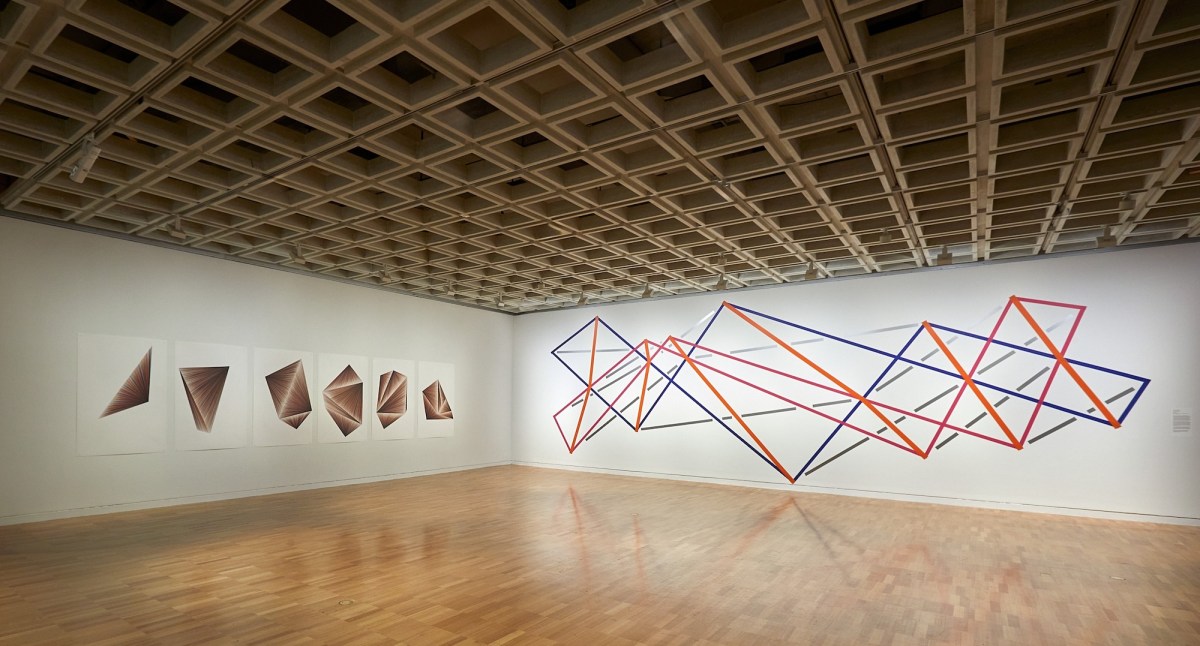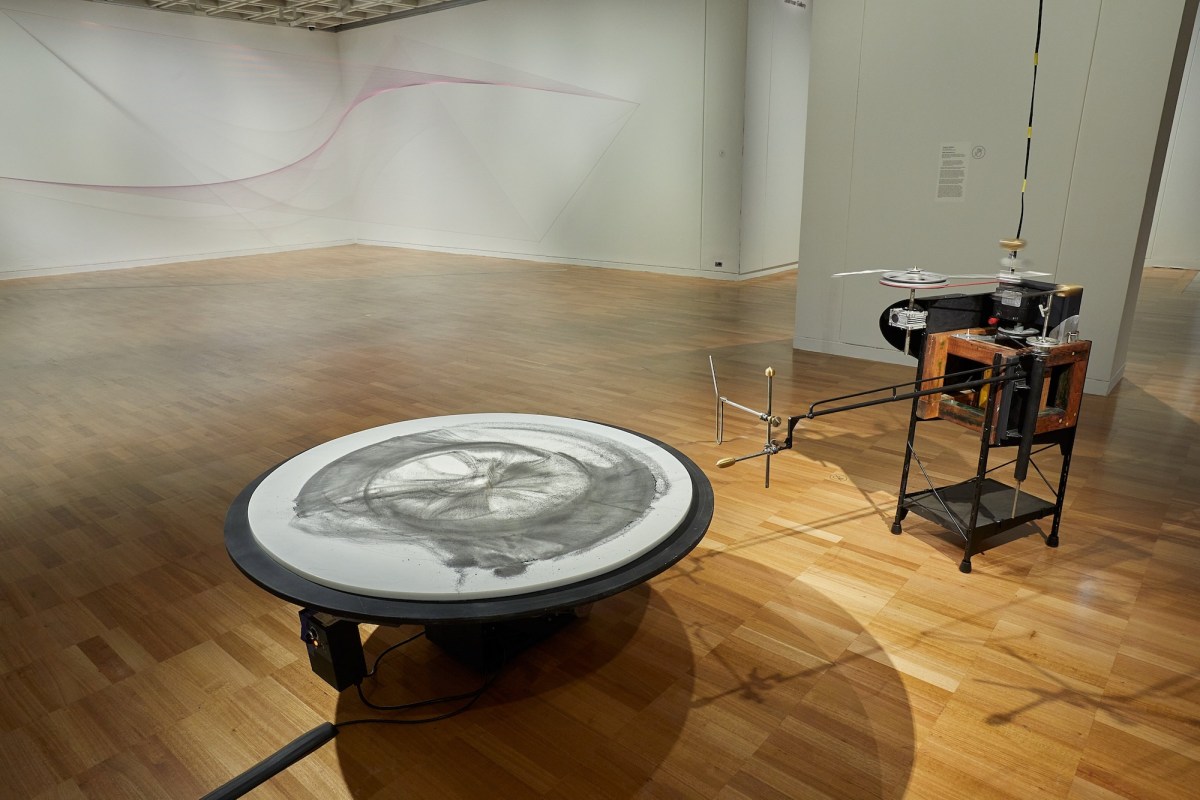Would you consider a solar-mechanised piece of charcoal dragged across a marble stone, or four kilometres of string pinned corner-to-corner, a drawing?
These are two considerations among a group of 10 artists who expand what drawing can be. You can see their work in the 2024 edition of the Dobell Australian Drawing Biennial, at the Art Gallery of NSW (AGNSW).
The Biennial grew out of the long-running Dobell Drawing Prize, and has been presented since 2014 (apart from 2022 due to COVID). Anne Ryan has been charged with the task of curating the Biennial, and has created a cracker exhibition this year – arguably its best yet.
Using abstraction as the foundation connecting these 10 artists, Ryan pushes drawing as far as she can, in terms of how materials are used to rethink drawing practice. Visitors get to consider the medium as a performative exercise and as a meditative one, and as one that can blur the boundaries of installation, sculpture and animation.
The linking thread is the role that endurance plays in the drawing practice of these artists.
A great example is the work of Emma Fielden (NSW), who has used a custom-made silver pipe – aka a flute – that she also plays while drawing with its tip onto a board. She references a very old technique of silver printing, expanding it into contemporary practice.
Made over the period of a week in the gallery, each mark is a fluid movement in sync with the breath and the note. Ryan notes it was mesmerising to watch, and visitors can view these pieces with the soundscape from their making.

Moving from something so labour intensive and analogue to new technologies is the work of Cameron Robbins, Helio Ephemera (2022). His drawing is created by a solar-powered mechanical arm that draws a line across a rondel of marble – the pace determined by the sun. He is effectively handing over the drawing process to nature.
While, again, this is mesmerising to ponder, Robbins asks some big questions with his piece in terms of how energies keep the planet going, our use of those energies, and – with an ephemeral drawing that is regularly wiped from the marble slab – about the permanency of the man-made intervention.
Robbins’ piece sits central to the exhibition, which is loosely divided into 10 alcoves across three galleries – Ryan giving each artist the space to really play out their practice – unlike the earlier Dobell Drawing Prize, which relied on single entries to explore the medium’s diversity.
This has been the win of the Biennial’s development, and it elevates the role – even status – placed on drawing practice.
In the first gallery, and within sight of Robbins’ work, is another artist using the circle motif. Ceara Metlikovec’s The Path of the Solar Barque (2024) is created by using a builder’s scribe to score into pinewood. The meticulous web of lines is built up over time, while listening to music. “[Metlikovec] sees sound in the earth, in structures,” explains Ryan.
That sense of task-driven, imposed parameters for drawing is further explored by Kate Vassallo, who uses a set of 100 colour pencils, which are laid out in a set order, and follows ‘rules’ – aka when they can be sharpened, what direction the line can be drawn, the starting and end point – to create her incredible suite of works on paper. They are the highlight of this exhibition.
They link nicely to works by Helen Eager, Sandra Selig and Kerrie Poliness – moving from pencil on paper to animation, to installation and to wall drawings.
Eager has expanded her focused obsession with the triangle into new animated forms, that are shown alongside a grid presentation of their source drawings. The animation seemingly vibrates off the wall, and is an exciting new development to her work.
Ryan’s placement next to Sandra Selig’s string drawing makes sense as that drawn line continues to take flight. For a corner of the gallery, she has used around 800 nails to install her web line drawing, which takes its cue from sine waves, used to explain energy forces. I am reminded of the work of US artist Fred Sandback using the wall and string to complete his spatial drawings.
Poliness, whose work I haven’t seen for a while, is just as polished as ever. However, it is clear to see that she is complicating her wall drawings – elements of her grids seemingly removed. Like Vassallo she is working with self-imposed rules and propositions, to force her drawing into a more rigorous, elevated practice. The performative aspect of her work means it sits beautifully together with that of Vassallo and Fielden, without being obvious.

A final nod needs to be given to Matthew Allen for his stunning surfaces of polished graphite, meticulously burnished by hand – Ryan again bringing in that connecting aspect of endurance in many drawing practices. Allen has also pushed his practice with a new addition of acrylic colour tiles in contract to the graphite – a great new step.
Read: Exhibition review: Primavera 2024: Young Australian Artists, MCA
This exhibition elevates drawing from outdated perceptions that it just a foundational process. These 10 artists collectively present a vibrant and exciting practice, which is layered and nuanced and, in some cases, has deep conceptual foundations.
There are some old favourites in this Biennial, but they are pushing their work in new directions, which is the great gift of the exhibition. Ryan has given us a great mix from early to late career artists, and a geographic spread too, which is fabulous for a viewer.
The resounding walk-away from the Infinite Drawing Biennial is the artist’s hand in these works – both its presence or absence – and how the hand, body and mine become one in the delivery of these works. It is an excellent – and thought-provoking – exhibition.
Infinite: Dobell Australian Drawing Biennial 2024
Curator: Anne Ryan
Art Gallery of New South Wales
Naala Nura, south building
Lower level 2
14 September 2024 – 12 January 2025, Free
Artists: Matthew Allen (NSW), Helen Eager (NSW), Emma Fielden (NSW), the late Ngarralja Tommy May (WA), Ceara Metlikovec (NSW), Kerrie Poliness (Vic), Cameron Robbins (Vic), Sandra Selig (Qld), Kate Vassallo (ACT) and Savanhdary Vongpoothorn (ACT)





